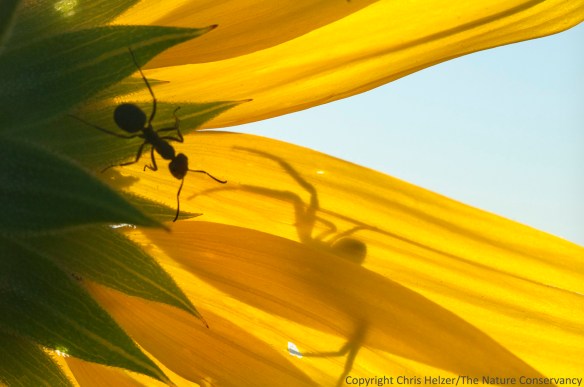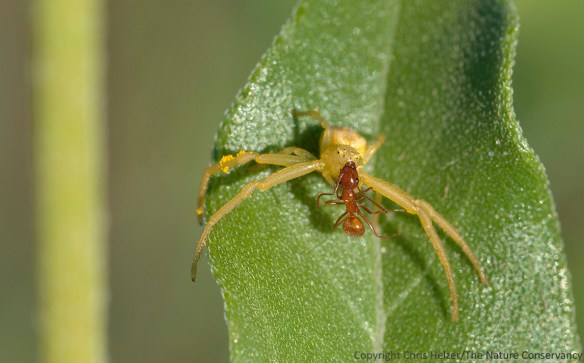Sometimes danger is waiting just around the corner…

An ant explores an annual sunflower for extra-floral nectar, seemingly unware of the crab spider lurking on the other side of the petals. The Nature Conservancy’s Niobrara Valley Preserve – Nebraska.
Last summer, I wrote a post about annual sunflowers, including a short bit about how sunflowers secrete extra-floral nectar to attract ants. The ants eat the sweet substance and may help repel potential herbivores from the sunflower in return. As you might expect, however, an abundance of ants can also be a potential source of food for other predators – including crab spiders. When I was at our Niobrara Valley Preserve last week, I noticed several instances where crab spiders were hanging around on sunflowers. They probably weren’t waiting specifically for ants, but apparently ants are an acceptable prey item if they happen to be available (see below).

A crab spider feeds on an ant it caught on an annual sunflower. This photo was taken a few minutes after the above photo, but it wasn’t the same sunflower, spider, or ant shown in that first photo.
…and that’s life – and death – in the prairie.

Fascinating natural history info Chris. One more thing to look for when I am out on the prairie. Thanx for sharing!!
What a fun and dramatic photo! I can just hear the ‘dum dum dum’ background music. This would be perfect for a children’s book; call it “Danger on the Prairie!” and throw in some of your other great predator/prey insect photos.
I’ve actually been a little concerned about the relative scarcity of pollinators of any kind I’ve seen so far this year. Presently I see more ants than anything else. Have seen many fewer bees, butterflies, moths, and even beetles compared to last year. Although I’ve been happily surprised to find more native ladybugs with their black heads.
Chris,
Great photo of the crab spider and the ant. Would you grant permission to use photos and your narrative in our newsletter, the Reverchon Naturalist http://www.nrcs.usda.gov/wps/portal/nrcs/detail/tx/newsroom/factsheets/?cid=nrcs144p2_003087
We would even plug your blog.
Ricky
Thanks Ricky – sure you may use it in your newsletter.
It’s definitely a bug-eat-bug world out there! I knew the ant wasn’t the same in the two pictures, because indeed, I’m almost certain they are different species. I was just about to write that, when I read your second caption. :)
The surprise to me is to see the ant that is prey in the second picture up there at Niobrara – It’s not one I’d expect up there, just demonstrating my need to get up that way some day.
Wow, Chris. What an excellent photo of the ant and lurking spider.
Wow, Chris. What an excellent photo with the silhouette of the lurking crab spider.
Looking in my garden I noticed something interesting. The aphids on butterfly milkweed pedicles were orange. This is a different color than aphids on any of my other plants.
James
One usually wouldn’t think of spiders as pollinators… but it’s clear they must serve as incidental pollinators. Very cool shot.
This is a bit of a stretch, Mike, but I suppose when they drag their bee prey around the flower hiding from passing shadows, some incidental pollination may occur. Flower spiders are not hairy, but with their yellow color, pollen on them would be hard to see, so this ought to be investigated. The thing is, an animal such as this that sits in ambush on a single flower or flower head for days on end wouldn’t be a very effective pollinator.
Beautiful photo, like my twins tell me, circle of life.